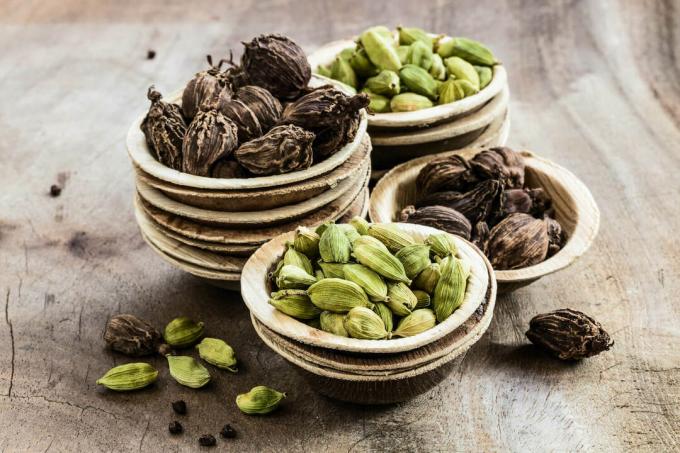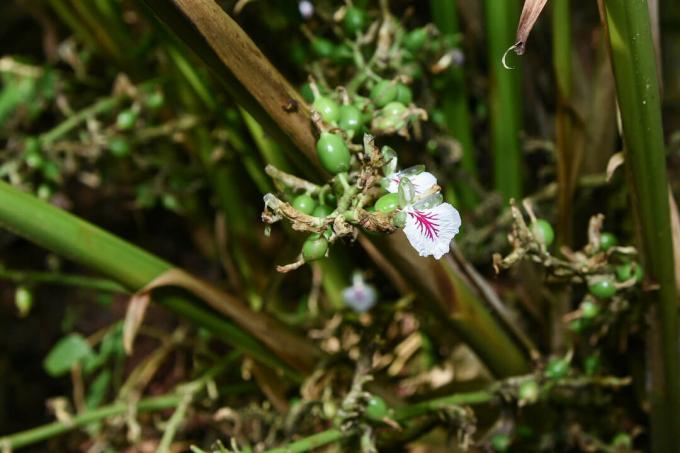Cardamom is known for its very versatile uses. Although you cannot harvest seeds in this country, we will show you how you can grow the exotic ornamental plant yourself to obtain the leaves that can also be used.

Cardamom is a very special spice that quickly awakens our wanderlust for South Asia. In this article, you will learn all about the uniquely flavorful cardamom pods, where they come from, how to plant, and how to use cardamom.
contents
- Cardamom: origin and properties of the spice
-
Different types of cardamom
- Black cardamom
- White or Green Cardamom
- Planting cardamom: site conditions and Co.
- multiply cardamom
- Cardamom care: repotting, fertilizing and watering
- Overwinter cardamom
- Cardamom: uses, taste and effects
Cardamom: origin and properties of the spice
cardamom (Elettaria cardamomum) belongs to the ginger family (Zingiberaceae) and is therefore not only associated with the ginger (Zingiber officinalis
), but also closely with turmeric (Curcuma longa) and galangal (Alpinia officinarum) related. The thick-rooted tropical perennial comes from the Indian Himalaya region and is now also grown commercially on a large scale in Tanzania, Thailand, Guatemala and Honduras. The plant reaches a height of up to 3 meters and usually thrives in the semi-shade to shade of tropical forests.The lanceolate leaves of cardamom are bushy and arranged in a manner reminiscent of palm fronds. Similar to ginger, thick rhizomes are formed in the soil to survive. The white cardamom blossom is strongly reminiscent of an orchid, has blue stripes and yellow petal edges. This is where the three-fold capsule fruits used as a spice develop, each containing 15 to 20 angular, brown seeds. The seeds contain almost all of the flavor in the capsules. The seed pods are harvested immature and dried directly, sometimes bleached. The spice is after saffron (Crocus sativus), vanilla (vanilla sp.) and nutmeg (Myristica fragrans) one of the most expensive spices in the world.
notice: Incidentally, the spice is often pronounced “cardamom”. Since the name (Elettaria cardamomum) but comes from Latin, the correct spelling is “cardamom”.
Different types of cardamom
When it comes to cardamom, most people think of light green pods. However, there is also a black cardamom variety. We present the species used as a spice.
Black cardamom
The black cardamom (Amomum subulatum) is a separate species within the ginger family and has deep brown, almost black seed pods, which are also larger than those of conventional cardamom. The taste of black cardamom is smoky and tart, it is popular in Sri Lanka for flavoring and making liquor.

White or Green Cardamom
White cardamom is the name given to the bleached seed pods of conventional cardamom, which are harvested unripe and have a delicate beige colour. However, the best quality is dried cardamom without further processing with the typical, pale green capsules. Its taste is milder than that of black cardamom and has no smoky note. The species is divided into the two variants used as a spice, Malabar cardamom (Elettaria cadamomum var. cardamomum) and the less popular Ceylon cardamom (Elettaria cadamomum var. major).
Planting cardamom: site conditions and Co.
The heat-loving cardamom plant can only be kept as a houseplant in our latitudes. You cannot harvest seeds here, but the leaves also have the typical cardamom taste and smell aromatic. This is because cardamom requires consistently high temperatures of around 25°C and long exposure times that are only found in the tropics. The tropical spice does not come into bloom with us. The plant can be kept very well indoors, as it also gets along well with partial shade and shady places. It does not require direct sunlight and does not tolerate it well. Cardamom is one of those edible houseplants.
Cardamom plants do not grow outdoors in our country, because they come from the tropics and do not tolerate temperatures below 15 °C. The plants should therefore be kept in pots and placed outside at most in summer, but then in semi-shade to shade. As soon as the night-time temperatures fall below the minimum temperature in autumn, the cardamom must be brought indoors and overwintered there bright and warm.

multiply cardamom
You can grow your own houseplant from fresh cardamom pods. The seeds contained in it are soaked in lukewarm water for about 24 hours and then sown in nutrient-poor soil, like ours Plantura herbal and seed soil. The cardamom seed should only be covered with a little substrate and kept well moist. Older seeds from the spice rack do not germinate very well, so you should buy fresh seeds for sowing. At 20 to 25 °C and a bright but not sunny location, the first cardamom plants will germinate after two to three weeks. After a few weeks, they can be pricked out and transplanted into more nutrient-rich soil.
If you already have a cardamom plant, the thick rhizome can be divided in the spring after the winter. As with ginger, the thickened root, together with the fine roots, is divided into several sections with dormant buds and placed in their own pots. As many of the fine white fine roots as possible should be preserved so that the cardamom plant can grow quickly in the pot and form fresh shoots.
Cardamom care: repotting, fertilizing and watering
The expensive spice plant should be repotted annually to give its rhizome enough space. This can happen from spring to autumn. For repotting the cardamom, a larger planter is first covered with a drainage layer and then filled with nutrient-rich potting soil, after carefully removing the plant into the new one pot set. The rhizome is covered with soil, lightly pressed and watered well.
From time to time fertilization of the cardamom is also necessary, especially when young leaves are harvested. When repotting, a long-term fertilizer can be added directly to the soil or alternatively the potted plant can be regularly treated with an organic liquid fertilizer of organic quality, such as ours Plantura organic indoor and green plant fertilizer, to be fertilized. This is added to the watering water about every two to three weeks and given when watering. This ensures a constant but gentle supply of nutrients, which prevents deficiency symptoms such as yellow leaves and supports the growth of the cardamom. At the same time, the liquid fertilizer comes to you in sustainable packaging.
When watering the tropical houseplant, the top layer of soil should be dry before the next watering.
tip: Fertilizing with a liquid fertilizer in the irrigation water saves time and is easy to do. Our Plantura organic indoor and green plant fertilizer supplies your indoor plants with all the important nutrients.
Overwinter cardamom
Cardamom is only wintered indoors and above 15 °C. In the cold season from October to March, there is no fertilizer and only little watering, because the plants hardly absorb any water and the root ball tends to rot if too much moisture can remain for a long time. You just have to make sure that the root ball does not dry out completely.
Tip: Potted plants often have to struggle with pests, especially in winter quarters. Many pests can multiply rapidly in our warm living spaces and also find no natural enemies. Typical pests on cardamom in the house are Mealybugs or Mealybugs, which form a white, fluffy ball of secretions from the carapace and feed on the plant sap.
Cardamom: uses, taste and effects
The taste of cardamom can be described as slightly bitter to floral-sweet and spicy-fiery. The young leaves also taste sweet and spicy, while older leaves become incredibly bitter and are no longer tempting to be eaten.

Cardamom is not only popular as a spice in its home countries of South Asia. In Sweden, about a quarter of the world's production is eaten in the form of the delicious "Kardemumma Bullar", a variant of the well-known cinnamon roll. If you mix some freshly ground cardamom into coffee, the effects of the caffeine are increased. Cardamom can be enjoyed baked, ground or hot infused as pure cardamom tea or as an ingredient in traditional chai tea. You can now and then chew whole capsules of cardamom against bad breath and thus even counteracts tooth decay. Cardamom powder should be used as soon as possible, as it loses its aromatic substances quickly. It is best to store the still whole capsules in airtight containers for about a year without any loss of taste.
Cardamom is a healthy spice that has always been used in Ayurvedic medicine. The seeds are said to have heart and stomach strengthening, antispasmodic and antiseptic effects.
Not only the cardamom finds a place outside of the tropics in our rooms. Discover more exciting ones in our special article exotic houseplants like pineapple and baobab.
